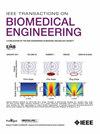Cortical Activation Patterns Determine Effectiveness of rTMS-Induced Motor Imagery Decoding Enhancement in Stroke Patients
IF 4.4
2区 医学
Q2 ENGINEERING, BIOMEDICAL
引用次数: 0
Abstract
Combination therapy with motor imagery (MI)-based brain-computer interface (BCI) and repetitive transcranial magnetic stimulation (rTMS) is a promising therapy for poststroke neurorehabilitation. However, with patients’ individual differences, the clinical effects vary greatly. This study aims to explore the hypothesis that stroke patients show individualized cortical response to rTMS treatments, which determine the effectiveness of rTMS-induced MI decoding enhancement. We applied four kinds of rTMS treatments respectively to four groups of subacute stroke patients, twenty-six patients in total, and observed their EEG dynamics, MI decoding performance, and Fugl-Meyer assessment changes following 2-week neuromodulation. Four treatments consisted of ipsilesional 10 Hz rTMS, contralesional 1 Hz rTMS, ipsilesional 1 Hz rTMS, and sham stimulation. Results showed stroke patients with different neural reorganization patterns responded individually to rTMS therapy. Patients with cortical lesions mostly showed contralesional recruitment and patients without cortical lesions mostly presented ipsilesional focusing. Significant activation increases in the ipsilesional hemisphere (pre: −15.7% ∓ 8.2%, post: −17.3% ∓ 8.1%, p = 0.037) and MI decoding accuracy enhancement (pre: 76.3 ± 13.8%, post: 86.6 ± 8.2%, p = 0.037) were concurrently found in no-cortical-lesion patients with ipsilesional activation treatment. In the group of patients without cortical lesions, recovery rate in those receiving ipsilesional activation therapy (23.5 ± 10.4%) was higher than those receiving ipsilesional suppression therapy (9.9 ± 9.3%) (p = 0.041). This study reveals that tailoring neuromodulation therapy by recognizing cortical activation patterns is promising for improving effectiveness of the combination therapy with BCI and rTMS.皮层激活模式决定经颅磁刺激诱导的脑卒中患者运动想象解码增强的效果
基于运动想象(MI)的脑机接口(BCI)和重复经颅磁刺激(rTMS)联合疗法是一种很有前景的脑卒中后神经康复疗法。然而,由于患者的个体差异,临床效果也大相径庭。本研究旨在探讨脑卒中患者皮层对经颅磁刺激治疗表现出个体化反应的假设,这种反应决定了经颅磁刺激诱导的 MI 解码增强的效果。我们对四组亚急性脑卒中患者(共 26 人)分别进行了四种经颅磁刺激治疗,并观察了他们在接受神经调控两周后的脑电图动态、MI 解码能力和 Fugl-Meyer 评估变化。四种治疗方法包括同侧 10 赫兹经颅磁刺激、对侧 1 赫兹经颅磁刺激、同侧 1 赫兹经颅磁刺激和假刺激。结果显示,不同神经重组模式的中风患者对经颅磁刺激疗法的反应各不相同。皮质病变患者大多表现为对侧集聚,而非皮质病变患者大多表现为同侧集聚。在接受同侧激活治疗的无皮质病变患者中,同时发现同侧半球的激活显著增加(治疗前:-15.7% ∓8.2%,治疗后:-17.3% ∓8.1%,p = 0.037),MI 解码准确率显著提高(治疗前:76.3 ± 13.8%,治疗后:86.6 ± 8.2%,p = 0.037)。在没有皮质病变的患者组中,接受同侧激活治疗的患者的康复率(23.5 ± 10.4%)高于接受同侧抑制治疗的患者(9.9 ± 9.3%)(p = 0.041)。这项研究表明,通过识别皮层激活模式来定制神经调控疗法,有望提高BCI和经颅磁刺激联合疗法的疗效。
本文章由计算机程序翻译,如有差异,请以英文原文为准。
求助全文
约1分钟内获得全文
求助全文
来源期刊

IEEE Transactions on Biomedical Engineering
工程技术-工程:生物医学
CiteScore
9.40
自引率
4.30%
发文量
880
审稿时长
2.5 months
期刊介绍:
IEEE Transactions on Biomedical Engineering contains basic and applied papers dealing with biomedical engineering. Papers range from engineering development in methods and techniques with biomedical applications to experimental and clinical investigations with engineering contributions.
 求助内容:
求助内容: 应助结果提醒方式:
应助结果提醒方式:


